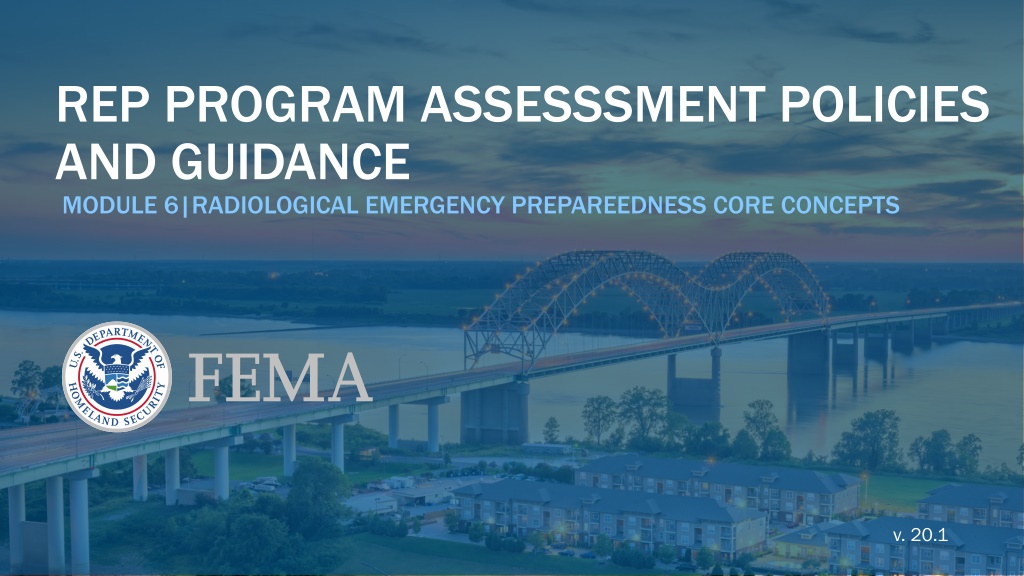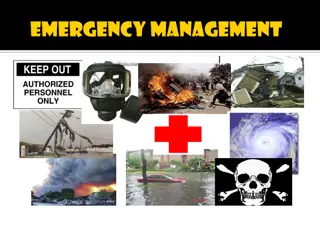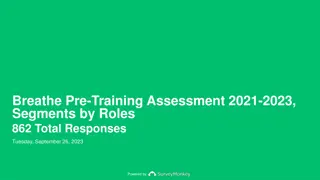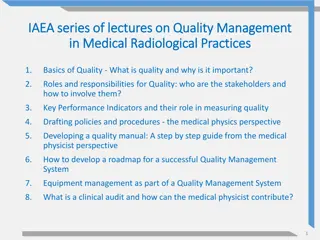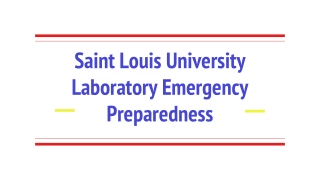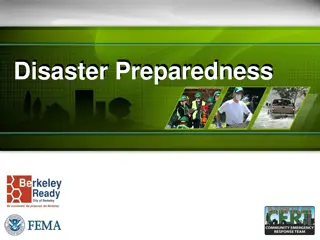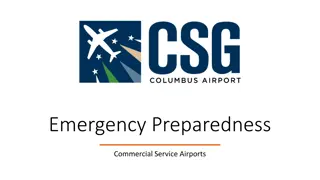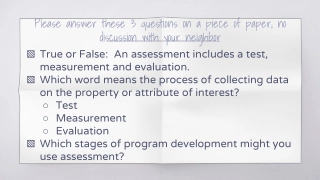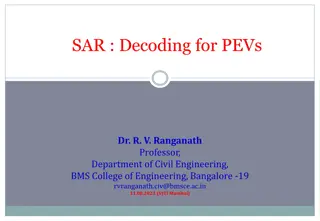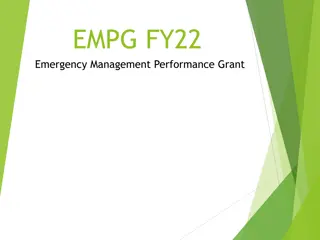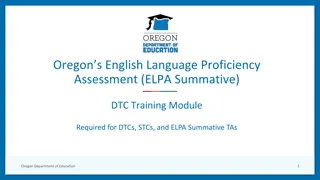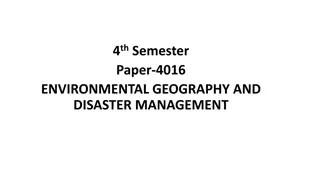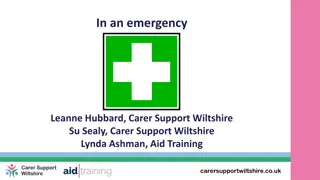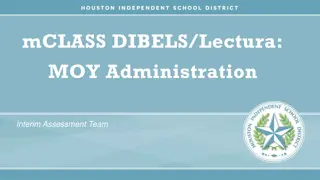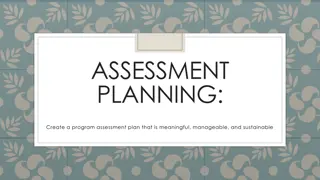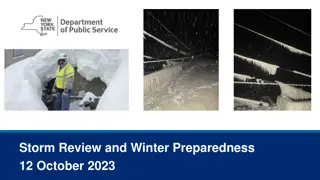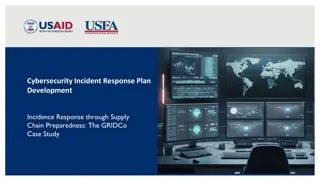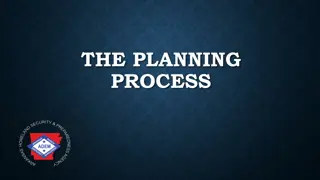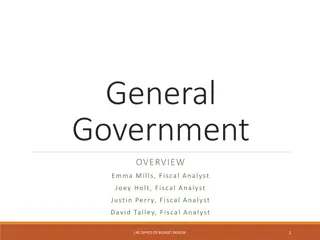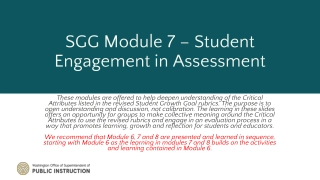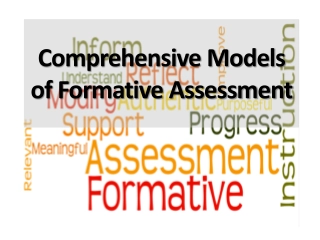Radiological Emergency Preparedness Program Assessment Guidance
This module covers the assessment policies and guidance for radiological emergency preparedness programs. It includes key concepts such as metrics for program evaluation, FEMA's assurance determination process, specific demonstration requirements, capability targets, and critical tasks. Participants will learn about the objectives and capability targets related to emergency operations management, exposure control, alert and notification, detection, and operation.
Download Presentation
Please find below an Image/Link to download the presentation.
The content on the website is provided AS IS for your information and personal use only. It may not be sold, licensed, or shared on other websites without obtaining consent from the author. Download presentation by click this link. If you encounter any issues during the download, it is possible that the publisher has removed the file from their server.
Presentation Transcript
REP PROGRAM ASSESSSMENT POLICIES AND GUIDANCE MODULE 6|RADIOLOGICAL EMERGENCY PREPAREEDNESS CORE CONCEPTS v. 20.1
REP Core Concepts Course Module 1 - Welcome and Introductions/Course Overview Module 2 Technical Basis of the REP Program Module 3 Basis of the REP Program Module 4 REP Regulations and Guidance Module 5 REP Planning Standards and Guidance Module 6 Module 6 REP Program Assessment Policies and Guidance REP Program Assessment Policies and Guidance Module 7 Course Summary Federal Emergency Management Agency Federal Emergency Management Agency 6 - 2
Learning Objectives By the end of this module, the student should be able to: Describe the purpose of REP Assessment activities Describe the common metrics used to evaluate a REP Program activity during the biennial assessment period in terms of objectives, capability targets, and core capabilities. Understand FEMAs mechanism for making a reasonable assurance determination Federal Emergency Management Agency 6 - 3
REP Program Manual Part III REP Program Assessment Policies and Guidance Describes specific demonstration requirements In this Part of the RPM, FEMA provides guidance for REP controllers, evaluators, and those responsible for planning, preparing, and executing REP assessment activities. Federal Emergency Management Agency 6 - 4
REP Program Manual Describes specific Exercise Objectives The distinct outcomes an organization wishes to achieve during an assessment activity Describes specific Capability Targets Capability targets: performance thresholds for each core capability. REP Program-specific capability targets are derived from the planning standards of 44 CFR 350, support evaluation criteria from NUREG- 0654/FEMA-REP-1, Rev. 2, and are used as the baseline for assessing ORO preparedness in terms of core capabilities. Describes specific Critical Tasks Distinct elements required to perform a capability target. Federal Emergency Management Agency 6 - 5
REP Objectives and Capability Targets Objective 1 Objective 1: : Emergency Operations Management Objective 2 Objective 2: : Exposure Control Objective 3 Objective 3: : Alert and Notification Objective 4 Objective 4: : Detect, Measure, Sample, Analyze, and Assess Objective 5 Objective 5: : Operate Federal Emergency Management Agency Federal Emergency Management Agency 6 - 6
REP Objectives and Capability Targets Objective 1: Emergency Operations Management Capability Target 1.1: Mobilization Capability Target 1.2: Direction and Control Capability Target 1.3: Protective Action Recommendations Capability Target 1.4: Protective Action Decisions for the Plume Phase Capability Target 1.5: Protective Action Decision Implementation for the Plume Phase Capability Target 1.6: Protective Action Decisions for the Post-Plume Phase Capability Target 1.7: Protective Action Decision Implementation for the Post-Plume Phase Federal Emergency Management Agency 6 - 7
REP Objectives and Capability Targets Objective 2: Exposure Control Capability Target 2.1: Emergency Worker Exposure Control Decision-Making Process Capability Target 2.2: Emergency Worker Exposure Control Management Federal Emergency Management Agency 6 - 8
REP Objectives and Capability Targets Objective 3: Alert and Notification Capability Target 3.1: Communications Capability Target 3.2: Alert and Notification of the Public Capability Target 3.3: Emergency Information and Instructions for the Public and News Media Federal Emergency Management Agency 6 - 9
REP Objectives and Capability Targets Objective 4: Detect, Measure, Sample, Analyze, and Assess Capability Target 4.1: Field Monitoring Teams Management Capability Target 4.2: Plume Phase Measurements and Sampling Capability Target 4.3: Post-Plume Phase Measurements and Sampling Capability Target 4.4: Laboratory Operations Capability Target 4.5: Plume Phase Analysis and Dose Assessment Capability Target 4.6: Post-Plume Phase Sampling and Plan Development and Analysis Federal Emergency Management Agency 6 - 10
REP Objectives and Capability Targets Objective 5: Operate Capability Target 5.1: Monitoring, Decontamination, Sheltering, and Registration of Evacuees Capability Target 5.2: Monitoring and Decontamination of Emergency Workers, Equipment, and Vehicles Capability Target 5.3: Transportation and Treatment of Contaminated, Injured Individuals Capability Target 5.4: Traffic and Access Control Federal Emergency Management Agency 6 - 11
Assessment Activities FEMA s planning and preparedness assessment strategy uses a combination of exercises, drills, training, SAVs, and other forms of reporting to ensure that offsite planning and preparedness remains adequate to protect the health and safety of the public: Plan Reviews Annual Letter of Certification (ALC) Public Information Review* Exercises Drills Seminars and Training* Staff Assistance Visits (SAVs)* Actual Incidents* Preliminary Capabilities Assessments (PCAs) and Disaster-Initiated Reviews (DIRs) *additional assessments that are not in the following slides also apply Federal Emergency Management Agency 6 - 12
Plan Review A REP plan review is normally conducted by evaluating the plans/procedures against the entire set of NUREG-0654/FEMAREP-1, Rev. 2 evaluation criteria. A cross-reference between the corresponding evaluation criterion/criteria must be provided when plans/procedures are submitted for review to aid the reviewer in locating information. OROs and FEMA Regions review offsite plans/procedures annually for consistency. Federal Emergency Management Agency 6 - 13
Plan Review Evaluation Adequate Adequate Contents of the REP plans/procedures are consistent and in full compliance with the requirements delineated in the stated evaluation criterion. Adequate Adequate Corrections Must Be Made Corrections Must Be Made Contents of the REP plans/procedures are adequate, but before a determination can be made as to whether they can be implemented, corrections must be made to the plans/procedures or supporting measures must be demonstrated (e.g., adequacy and maintenance of procedures, training, resources, staffing levels and qualifications, and equipment) Inadequate Inadequate Contents of the REP plans/procedures do not satisfy the evaluation criterion. Not Applicable Not Applicable Evaluation criterion does not apply to the REP plans/procedures being reviewed. For example, some evaluation criteria may be applicable to state REP plans/procedures but may not apply to local plans/procedures. The result of the reviewer s evaluation is expressed as one of the following for each NUREG-0654/FEMA-REP-1, Rev. 2 evaluation criterion: Federal Emergency Management Agency 6 - 14
Annual Letter of Certification (ALC) The ALC assists FEMA in making reasonable assurance findings and determinations regarding offsite radiological emergency plans/procedures and preparedness. The ALC must include assurances that all requisite activities have been undertaken or completed, as appropriate, by OROs. The ALC submission for a given year is due by January 31 of the following year. 6 - 15 Federal Emergency Management Agency
Exercises & Drills Exercises are an instrument to train for, assess, practice, and improve performance of prevention, protection, mitigation, response, and recovery capabilities. Biennial REP exercises are required to test the integrated capabilities of the onsite and offsite emergency functions set forth in their radiological emergency response plans/procedures. Offsite periodic drills are conducted to develop and maintain key skills and capabilities necessary to fulfill functional roles. Federal Emergency Management Agency 6 - 16
Exercises & Drills The REP Program uses HSEEP Methodology The Homeland Security Exercise and Evaluation Program (HSEEP) provides a set of fundamental principles for exercise programs, as well as a common approach to program management, design and development, conduct, evaluation, and improvement planning. FEMA REP uses a set of programmatic-specific objectives/capability targets and associated core capabilities as a minimum baseline for assessment. Evaluation ties objectives to priorities, assesses the performance of capability targets and critical tasks, and documents strengths and areas for improvement. Federal Emergency Management Agency 6 - 17
Preliminary Capabilities Assessments (PCAs) & Disaster-Initiated Reviews (DIRs) When a natural or man-made disaster causes damage or alters the emergency response infrastructure or capabilities around an NRC-licensed NPP to the extent that the damage raises serious questions about the continued adequacy of offsite emergency preparedness. FEMA may elect to perform a PCA or DIR to assess the impact. FEMA uses a PCA to obtain a prompt assessment (snapshot) of offsite EP immediately following an incident to assist the FEMA Region/FEMA REP Program s joint determination on the need and timing for a DIR. Federal Emergency Management Agency 6 - 18
Preliminary Capabilities Assessments (PCAs) & Disaster-Initiated Reviews (DIRs) The review is provided to the NRC to assist in the decision of the NPP operations state or restart if it was shut down in response to a disaster. The PCA/DIR checklist is in the Interim SOG Assessment of Offsite Emergency Preparedness Infrastructure & Capabilities Some initiating events may be hurricanes, earthquakes, flooding, ice storms, etc. FEMA works with OROs to conduct PCA/DIRs assessing the offsite emergency response infrastructure within the EPZ If the status of offsite emergency preparedness is inadequate, it is imperative that appropriate compensatory measures are developed and implemented to ensure public health and safety. Federal Emergency Management Agency 6 - 19
Knowledge Check (1 of 2) Use your student manual to answer each question. Use your student manual to answer each question. Which document provides a detailed description of each of the five overarching Objectives and Capability Targets? REP Program Manual (RPM) Which Capability Target is included in Objective 1? Emergency Worker Exposure Control Management Communications Protective Action Decisions for the Plume Phase Traffic and Access Control Federal Emergency Management Agency 6 - 21
Knowledge Check (2 of 2) Use your student manual to answer each question. Use your student manual to answer each question. Which Capability Target is included in Objective 3? Alert and Notification of the Public Direction and Control Field Monitoring Teams Management Protective Action Recommendations Federal Emergency Management Agency 6 - 22
